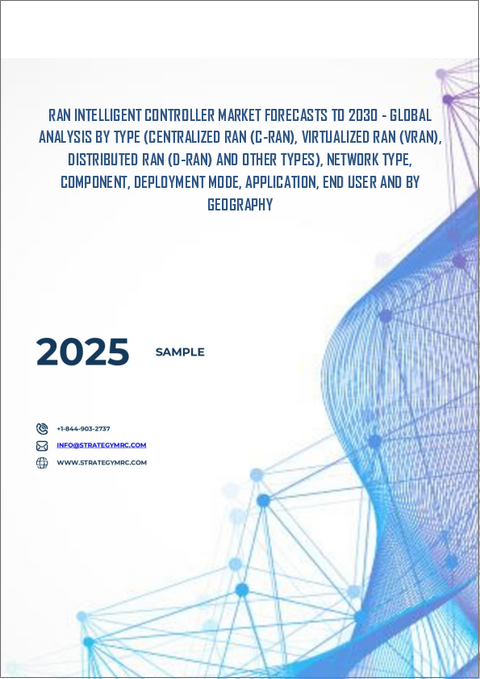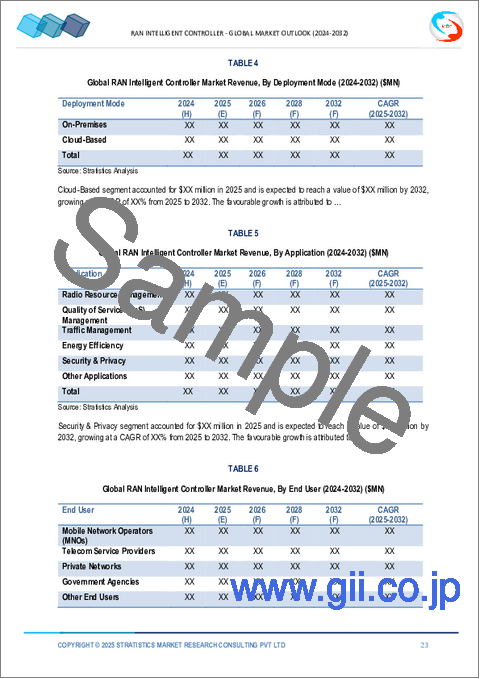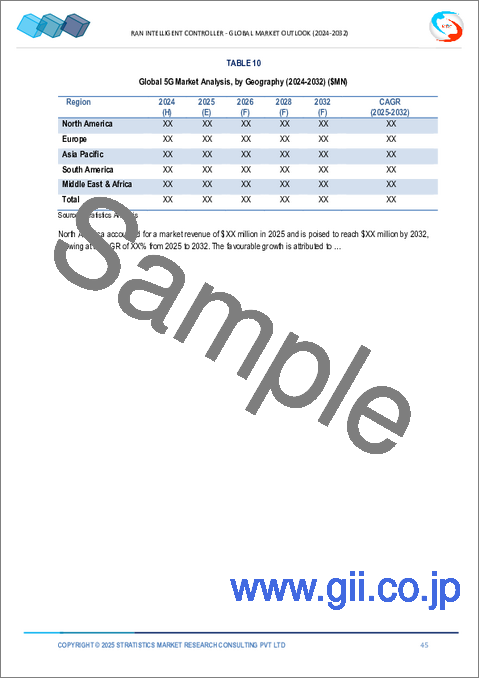|
|
市場調査レポート
商品コード
1625177
RANインテリジェントコントローラの2030年までの市場予測: タイプ別、ネットワークタイプ別、コンポーネント別、展開モード別、用途別、エンドユーザー別、地域別の世界分析RAN Intelligent Controller Market Forecasts to 2030 - Global Analysis By Type (Centralized RAN (C-RAN), Virtualized RAN (vRAN), Distributed RAN (D-RAN) and Other Types), Network Type, Component, Deployment Mode, Application, End User and By Geography |
||||||
カスタマイズ可能
|
|||||||
| RANインテリジェントコントローラの2030年までの市場予測: タイプ別、ネットワークタイプ別、コンポーネント別、展開モード別、用途別、エンドユーザー別、地域別の世界分析 |
|
出版日: 2025年01月01日
発行: Stratistics Market Research Consulting
ページ情報: 英文 200+ Pages
納期: 2~3営業日
|
全表示
- 概要
- 図表
- 目次
Stratistics MRCによると、RANインテリジェントコントローラの世界市場は2024年に2億4,235万米ドルを占め、2030年には45億7,892万米ドルに達すると予測され、予測期間中のCAGRは63.2%です。
RANインテリジェントコントローラは、モバイルネットワークのRAN運用を最適化・管理するために設計されたソフトウェアベースのソリューションです。人工知能と機械学習を使用してリソース、トラフィックルーティング、ネットワークスライシングを動的に制御することで、ネットワークの効率を高めます。このコントローラは、パフォーマンスの向上、待ち時間の短縮、異なるRANエレメント間での効率的なスペクトラム利用を支援します。トラフィック需要やネットワーク状況にリアルタイムでインテリジェントに適応することで、最新のセルラーネットワークにおける柔軟性、拡張性、自動化の向上を可能にします。
GSM協会(GSMA)の2022年モバイルエコノミーレポートによると、2021年には4Gが接続の58%を占める
5G技術の採用拡大
5Gネットワークでは、膨大なデータトラフィック、IoTデバイス、多様なユースケースをサポートするために、最適化された無線リソース管理、低遅延、容量強化が必要です。RANインテリジェントコントローラは、通信事業者がネットワーク管理を自動化し、リソースを効率的に割り当て、ネットワークパフォーマンスを向上させることを可能にします。これらのコントローラは、5Gが約束する非常に高い信頼性と高性能の接続性を実現するのに役立ち、5Gネットワークの世界の展開と拡張を成功させるために不可欠なコンポーネントとなっています。
統合の複雑さ
RANインテリジェントコントローラにおける統合の複雑さは、既存の、しばしば時代遅れのネットワークインフラに新しい技術を組み込むという課題から生じます。インテリジェントコントローラとレガシーシステム間の互換性を確保することが困難になります。その結果、こうした複雑さが原因でRANインテリジェントコントローラの導入が遅れ、市場全体の成長と、より効率的で自動化されたネットワークへの移行を妨げています。
ネットワークの自動化と仮想化への需要の高まり
通信事業者が効率性の向上、運用コストの削減、5Gの展開をサポートするために自動化、仮想化ネットワークに移行する中、RANインテリジェントコントローラはこの変革において重要な役割を果たしています。ネットワークのスケーラビリティ、柔軟性、応答性を強化することで、RANインテリジェントコントローラは、通信事業者が効率的で俊敏、かつ将来性のあるネットワークインフラに対するニーズの高まりに対応できるよう支援します。そのため、ネットワークの自動化と仮想化に対する需要の高まりが、RANインテリジェントコントローラー市場の成長を促す要因となっています。
高い実装コスト
RANインテリジェントコントローラの導入コストが高いのは、既存のネットワークインフラにシステムを導入・統合するために、高度なハードウェア、ソフトウェア、専門的な専門知識が必要になることに起因します。このような財政的な障壁は、事業者がこれらの技術の採用を遅らせたり見送ったりする可能性があるため、市場の成長を妨げます。さらに、RANインテリジェントコントローラをレガシーシステムと統合する複雑さにより、導入コストが増大し、普及がさらに制限され、市場の拡大が遅れる可能性があります。
COVID-19の影響
COVID-19の大流行は、リモートワークやデータ消費の増加によりネットワークインフラへの圧力が高まるにつれ、RANインテリジェントコントローラの需要を加速させました。通信事業者は、急増するトラフィックを処理し、シームレスな接続性を確保するため、ネットワークの最適化と自動化に注力しました。しかし、サプライチェーンの混乱、5G導入の遅れ、予算の制約により、高度なRAN技術への投資ペースは鈍化しました。こうした課題にもかかわらず、パンデミックは、より俊敏でスケーラブルかつ効率的なネットワークの必要性を浮き彫りにし、長期的な市場成長を後押ししました。
予測期間中、無線リソース管理分野が最大になる見込み
無線リソース管理(RRM)分野は、予測期間を通じて最大の市場シェアを確保すると予測されています。RRM用途では、RANインテリジェントコントローラがネットワークリソースの割り当てと利用を最適化する上で重要な役割を果たします。無線スペクトラム、電力レベル、ユーザー接続を動的に管理し、効率的なネットワーク性能を確保します。その結果、ネットワーク容量が向上し、待ち時間が短縮され、全体的なユーザー体験が向上します。
予測期間中、通信サービスプロバイダー分野のCAGRが最も高くなる見込み
予測期間中、CAGRが最も高くなると予測されているのは通信サービスプロバイダ分野です。RANインテリジェントコントローラは、強化されたネットワーク管理と最適化を可能にするため、通信サービスプロバイダにとって極めて重要です。これらのコントローラは、無線リソースの動的割り当てを容易にし、ネットワークの効率、容量、パフォーマンスを向上させます。これらのコントローラは、ネットワークスライシングなどの高度な機能をサポートし、多様なユーザー要件や使用事例に対応したシームレスなサービス提供を実現します。
最大のシェアを持つ地域
アジア太平洋地域は、5Gネットワークの急速な拡大、ネットワーク自動化需要の増加、同地域の技術進歩により、予測期間中に最大の市場シェアを記録すると予想されます。中国、日本、韓国、インドなどの国々は、ネットワーク性能の最適化、遅延の削減、効率の向上を目的としたRANソリューションの導入でリードしています。スマートシティの推進、IoT接続、データ消費の増大が、RANインテリジェントコントローラの採用をさらに促進しています。
CAGRが最も高い地域:
北米は、5Gネットワークの広範な展開とネットワークの自動化と最適化に対する需要の高まりにより、予測期間中に最も高いCAGRを記録すると予想されます。米国とカナダは、ネットワーク効率を高めるために先進的なRAN技術の採用でリードしています。さらに、デジタル変革、スマートシティ、IoT接続に注力する同地域は、統合とコストの課題にもかかわらず、市場の成長をさらに促進しています。
無料のカスタマイズサービス:
本レポートをご購読のお客様には、以下の無料カスタマイズオプションのいずれかをご利用いただけます:
- 企業プロファイル
- 追加市場プレイヤーの包括的プロファイリング(3社まで)
- 主要企業のSWOT分析(3社まで)
- 地域セグメンテーション
- 顧客の関心に応じた主要国の市場推計・予測・CAGR(注:フィージビリティチェックによる)
- 競合ベンチマーキング
- 製品ポートフォリオ、地理的プレゼンス、戦略的提携に基づく主要企業のベンチマーキング
目次
第1章 エグゼクティブサマリー
第2章 序文
- 概要
- ステークホルダー
- 調査範囲
- 調査手法
- データマイニング
- データ分析
- データ検証
- 調査アプローチ
- 調査情報源
- 1次調査情報源
- 2次調査情報源
- 前提条件
第3章 市場動向分析
- ドライバー
- 抑制要因
- 機会
- 脅威
- 用途分析
- エンドユーザー分析
- 新興市場
- COVID-19の影響
第4章 ポーターのファイブフォース分析
- 供給企業の交渉力
- 買い手の交渉力
- 代替品の脅威
- 新規参入業者の脅威
- 競争企業間の敵対関係
第5章 世界のRANインテリジェントコントローラ市場:タイプ別
- 集中型RAN(C-RAN)
- 仮想型RAN(vRAN)
- 分散型RAN(D-RAN)
- その他のタイプ
第6章 世界RANインテリジェントコントローラ市場:ネットワークタイプ別
- 4G/LTE
- 5G
- レガシーネットワーク
- その他のネットワークタイプ
第7章 世界RANインテリジェントコントローラ市場:コンポーネント別
- ハードウェア
- サーバー
- スイッチ
- プロセッサ
- ソフトウェア
- ネットワーク管理ソフトウェア
- 自動化ソフトウェア
- サービス
- プロフェッショナルサービス
- マネージドサービス
第8章 世界RANインテリジェントコントローラ市場:展開モード別
- オンプレミス
- クラウドベース
第9章 世界RANインテリジェントコントローラ市場:用途別
- 無線リソース管理
- サービス品質(QoS)管理
- 交通管理
- エネルギー効率
- セキュリティとプライバシー
- その他の用途
第10章 世界RANインテリジェントコントローラ市場:エンドユーザー別
- モバイルネットワークオペレーター(MNO)
- 通信サービスプロバイダー
- プライベートネットワーク
- 政府機関
- その他のエンドユーザー
第11章 世界のRANインテリジェントコントローラ市場:地域別
- 北米
- 米国
- カナダ
- メキシコ
- 欧州
- ドイツ
- 英国
- イタリア
- フランス
- スペイン
- その他欧州
- アジア太平洋
- 日本
- 中国
- インド
- オーストラリア
- ニュージーランド
- 韓国
- その他アジア太平洋地域
- 南米
- アルゼンチン
- ブラジル
- チリ
- その他南米
- 中東・アフリカ
- サウジアラビア
- アラブ首長国連邦
- カタール
- 南アフリカ
- その他中東とアフリカ
第12章 主な発展
- 契約、パートナーシップ、コラボレーション、合弁事業
- 買収と合併
- 新製品発売
- 事業拡大
- その他の主要戦略
第13章 企業プロファイリング
- Ericsson
- Nokia
- Cisco Systems
- Huawei
- Intel Corporation
- IBM Corporation
- Oracle Corporation
- Samsung
- Fujitsu Corporation
- Juniper Networks
- Affirmed Networks
- NEC Corporation
- EchoStar Corporation
- Mavenir
- ZTE Corporation
- Parallel Wireless
List of Tables
- Table 1 Global RAN Intelligent Controller Market Outlook, By Region (2022-2030) ($MN)
- Table 2 Global RAN Intelligent Controller Market Outlook, By Type (2022-2030) ($MN)
- Table 3 Global RAN Intelligent Controller Market Outlook, By Centralized RAN (C-RAN) (2022-2030) ($MN)
- Table 4 Global RAN Intelligent Controller Market Outlook, By Virtualized RAN (vRAN) (2022-2030) ($MN)
- Table 5 Global RAN Intelligent Controller Market Outlook, By Distributed RAN (D-RAN) (2022-2030) ($MN)
- Table 6 Global RAN Intelligent Controller Market Outlook, By Other Types (2022-2030) ($MN)
- Table 7 Global RAN Intelligent Controller Market Outlook, By Network Type (2022-2030) ($MN)
- Table 8 Global RAN Intelligent Controller Market Outlook, By 4G/LTE (2022-2030) ($MN)
- Table 9 Global RAN Intelligent Controller Market Outlook, By 5G (2022-2030) ($MN)
- Table 10 Global RAN Intelligent Controller Market Outlook, By Legacy Networks (2022-2030) ($MN)
- Table 11 Global RAN Intelligent Controller Market Outlook, By Other Network Types (2022-2030) ($MN)
- Table 12 Global RAN Intelligent Controller Market Outlook, By Component (2022-2030) ($MN)
- Table 13 Global RAN Intelligent Controller Market Outlook, By Hardware (2022-2030) ($MN)
- Table 14 Global RAN Intelligent Controller Market Outlook, By Servers (2022-2030) ($MN)
- Table 15 Global RAN Intelligent Controller Market Outlook, By Switches (2022-2030) ($MN)
- Table 16 Global RAN Intelligent Controller Market Outlook, By Processors (2022-2030) ($MN)
- Table 17 Global RAN Intelligent Controller Market Outlook, By Software (2022-2030) ($MN)
- Table 18 Global RAN Intelligent Controller Market Outlook, By Network Management Software (2022-2030) ($MN)
- Table 19 Global RAN Intelligent Controller Market Outlook, By Automation Software (2022-2030) ($MN)
- Table 20 Global RAN Intelligent Controller Market Outlook, By Services (2022-2030) ($MN)
- Table 21 Global RAN Intelligent Controller Market Outlook, By Professional Services (2022-2030) ($MN)
- Table 22 Global RAN Intelligent Controller Market Outlook, By Managed Services (2022-2030) ($MN)
- Table 23 Global RAN Intelligent Controller Market Outlook, By Deployment Mode (2022-2030) ($MN)
- Table 24 Global RAN Intelligent Controller Market Outlook, By On-Premises (2022-2030) ($MN)
- Table 25 Global RAN Intelligent Controller Market Outlook, By Cloud-Based (2022-2030) ($MN)
- Table 26 Global RAN Intelligent Controller Market Outlook, By Application (2022-2030) ($MN)
- Table 27 Global RAN Intelligent Controller Market Outlook, By Radio Resource Management (2022-2030) ($MN)
- Table 28 Global RAN Intelligent Controller Market Outlook, By Quality of Service (QoS) Management (2022-2030) ($MN)
- Table 29 Global RAN Intelligent Controller Market Outlook, By Traffic Management (2022-2030) ($MN)
- Table 30 Global RAN Intelligent Controller Market Outlook, By Energy Efficiency (2022-2030) ($MN)
- Table 31 Global RAN Intelligent Controller Market Outlook, By Security & Privacy (2022-2030) ($MN)
- Table 32 Global RAN Intelligent Controller Market Outlook, By Other Applications (2022-2030) ($MN)
- Table 33 Global RAN Intelligent Controller Market Outlook, By End User (2022-2030) ($MN)
- Table 34 Global RAN Intelligent Controller Market Outlook, By Mobile Network Operators (MNOs) (2022-2030) ($MN)
- Table 35 Global RAN Intelligent Controller Market Outlook, By Telecom Service Providers (2022-2030) ($MN)
- Table 36 Global RAN Intelligent Controller Market Outlook, By Private Networks (2022-2030) ($MN)
- Table 37 Global RAN Intelligent Controller Market Outlook, By Government Agencies (2022-2030) ($MN)
- Table 38 Global RAN Intelligent Controller Market Outlook, By Other End Users (2022-2030) ($MN)
Note: Tables for North America, Europe, APAC, South America, and Middle East & Africa Regions are also represented in the same manner as above.
According to Stratistics MRC, the Global RAN Intelligent Controller Market is accounted for $242.35 million in 2024 and is expected to reach $4578.92 million by 2030 growing at a CAGR of 63.2% during the forecast period. A RAN Intelligent Controller is a software-based solution designed to optimize and manage the operation of a mobile network's RAN. It enhances the network's efficiency by using artificial intelligence and machine learning to dynamically control resources, traffic routing, and network slicing. The controller helps improve performance, reduce latency, and ensure efficient spectrum use across different RAN elements. It enables greater flexibility, scalability, and automation in modern cellular networks, by intelligently adapting to traffic demands and network conditions in real-time.
According to the GSM Association (GSMA)'s 2022 mobile economy report, in 2021, 4G accounted for 58% of the connections.
Market Dynamics:
Driver:
Growing adoption of 5G technology
5G networks require optimized radio resource management, low latency, and enhanced capacity to support massive data traffic, IoT devices, and diverse use cases. RAN Intelligent Controllers enable telecom operators to automate network management, efficiently allocate resources, and improve network performance. These controllers help deliver the ultra-reliable, high-performance connectivity that 5G promises, making them a critical component in the successful deployment and scaling of 5G networks globally.
Restraint:
Integration complexities
Integration complexities in RAN intelligent controllers arise from the challenge of incorporating new technologies into existing, often outdated, network infrastructures. It creates difficulties in ensuring compatibility between the intelligent controller and legacy systems. As a result, the slow adoption of RAN intelligent controllers due to these complexities hampers overall market growth and the transition to more efficient, automated networks.
Opportunity:
Increasing demand for network automation and virtualization
As telecom operators transition to automated, virtualized networks to improve efficiency, reduce operational costs, and support the deployment of 5G, RAN Intelligent Controllers play a critical role in this transformation. By enhancing network scalability, flexibility, and responsiveness, RAN Intelligent Controllers help telecom providers meet the growing need for efficient, agile, and future-proof network infrastructures. Therefore, the increasing demand for network automation and virtualization is a key driver for the growth of the RAN Intelligent Controller market.
Threat:
High implementation costs
High implementation costs in RAN Intelligent Controllers stem from the need for advanced hardware, software, and specialized expertise to deploy and integrate the system into existing network infrastructures. This financial barrier hampers market growth as operators may delay or forgo the adoption of these technologies. Additionally, the complexity of integrating RAN Intelligent Controllers with legacy systems can increase implementation costs, further restricting widespread adoption and slowing market expansion.
Covid-19 Impact
The covid-19 pandemic accelerated the demand for RAN intelligent controllers as remote work and increased data consumption placed more pressure on network infrastructures. Telecom operators focused on network optimization and automation to handle surging traffic and ensure seamless connectivity. However, supply chain disruptions, delays in 5G deployments, and budget constraints slowed the pace of investment in advanced RAN technologies. Despite these challenges, the pandemic underscored the need for more agile, scalable, and efficient networks, boosting long-term market growth.
The radio resource management segment is expected to be the largest during the forecast period
The radio resource management segment is predicted to secure the largest market share throughout the forecast period. In RRM applications, RAN Intelligent Controllers play a crucial role in optimizing the allocation and utilization of network resources. They dynamically manage radio spectrum, power levels, and user connections to ensure efficient network performance. This results in improved network capacity, reduced latency, and better overall user experience.
The telecom service providers segment is expected to have the highest CAGR during the forecast period
The telecom service providers segment is anticipated to witness the highest CAGR during the forecast period. RAN intelligent controllers are crucial for telecom service providers as they enable enhanced network management and optimization. These controllers facilitate the dynamic allocation of radio resources, improving network efficiency, capacity, and performance. These controllers support advanced features such as network slicing, ensuring seamless service delivery across diverse user requirements and use cases.
Region with largest share:
Asia Pacific is expected to register the largest market share during the forecast period due to the rapid expansion of 5G networks, increasing demand for network automation, and the region's technological advancements. Countries like China, Japan, South Korea, and India are leading in deploying RAN solutions to optimize network performance, reduce latency, and improve efficiency. The push for smart cities, IoT connectivity, and higher data consumption is further driving the adoption of RAN Intelligent Controllers.
Region with highest CAGR:
North America is expected to witness the highest CAGR over the forecast period driven by the widespread deployment of 5G networks and the increasing demand for network automation and optimization. The U.S. and Canada are leading in adopting advanced RAN technologies to enhance network efficiency. Additionally, the region's focus on digital transformation, smart cities, and IoT connectivity is further propelling market growth, despite challenges in integration and cost.
Key players in the market
Some of the key players profiled in the RAN Intelligent Controller Market include Ericsson, Nokia, Cisco Systems, Huawei, Intel Corporation, IBM Corporation, Oracle Corporation, Samsung, Fujitsu Corporation, Juniper Networks, Affirmed Networks, NEC Corporation, EchoStar Corporation, Mavenir, ZTE Corporation and Parallel Wireless.
Key Developments:
In July 2024, EchoStar Corporation unveiled the Open RAN Center for Integration and Deployment (ORCID). This new facility is a cutting-edge Open RAN (O-RAN) testing and evaluation lab, strategically located at EchoStar's data center in Cheyenne, Wyoming. This facility plays a critical role in advancing the adoption of Open RAN solutions, promoting interoperability, and accelerating the deployment of next-generation wireless networks, particularly in the context of 5G and beyond.
In February 2023, Mavenir launched the Open RAN Intelligent Controller (O-RIC), that marks a significant advancement in the world of telecommunications and network management, especially in the context of Open Radio Access Networks (Open RAN). The O-RIC offering is designed to enhance the efficiency and flexibility of 5G networks by enabling service differentiation and optimizing network resources.
Types Covered:
- Centralized RAN (C-RAN)
- Virtualized RAN (vRAN)
- Distributed RAN (D-RAN)
- Other Types
Network Types Covered:
- 4G/LTE
- 5G
- Legacy Networks
- Other Network Types
Components Covered:
- Hardware
- Software
- Services
Deployment Modes Covered:
- On-Premises
- Cloud-Based
Applications Covered:
- Radio Resource Management
- Quality of Service (QoS) Management
- Traffic Management
- Energy Efficiency
- Security & Privacy
- Other Applications
End Users Covered:
- Mobile Network Operators (MNOs)
- Telecom Service Providers
- Private Networks
- Government Agencies
- Other End Users
Regions Covered:
- North America
- US
- Canada
- Mexico
- Europe
- Germany
- UK
- Italy
- France
- Spain
- Rest of Europe
- Asia Pacific
- Japan
- China
- India
- Australia
- New Zealand
- South Korea
- Rest of Asia Pacific
- South America
- Argentina
- Brazil
- Chile
- Rest of South America
- Middle East & Africa
- Saudi Arabia
- UAE
- Qatar
- South Africa
- Rest of Middle East & Africa
What our report offers:
- Market share assessments for the regional and country-level segments
- Strategic recommendations for the new entrants
- Covers Market data for the years 2022, 2023, 2024, 2026, and 2030
- Market Trends (Drivers, Constraints, Opportunities, Threats, Challenges, Investment Opportunities, and recommendations)
- Strategic recommendations in key business segments based on the market estimations
- Competitive landscaping mapping the key common trends
- Company profiling with detailed strategies, financials, and recent developments
- Supply chain trends mapping the latest technological advancements
Free Customization Offerings:
All the customers of this report will be entitled to receive one of the following free customization options:
- Company Profiling
- Comprehensive profiling of additional market players (up to 3)
- SWOT Analysis of key players (up to 3)
- Regional Segmentation
- Market estimations, Forecasts and CAGR of any prominent country as per the client's interest (Note: Depends on feasibility check)
- Competitive Benchmarking
- Benchmarking of key players based on product portfolio, geographical presence, and strategic alliances
Table of Contents
1 Executive Summary
2 Preface
- 2.1 Abstract
- 2.2 Stake Holders
- 2.3 Research Scope
- 2.4 Research Methodology
- 2.4.1 Data Mining
- 2.4.2 Data Analysis
- 2.4.3 Data Validation
- 2.4.4 Research Approach
- 2.5 Research Sources
- 2.5.1 Primary Research Sources
- 2.5.2 Secondary Research Sources
- 2.5.3 Assumptions
3 Market Trend Analysis
- 3.1 Introduction
- 3.2 Drivers
- 3.3 Restraints
- 3.4 Opportunities
- 3.5 Threats
- 3.6 Application Analysis
- 3.7 End User Analysis
- 3.8 Emerging Markets
- 3.9 Impact of Covid-19
4 Porters Five Force Analysis
- 4.1 Bargaining power of suppliers
- 4.2 Bargaining power of buyers
- 4.3 Threat of substitutes
- 4.4 Threat of new entrants
- 4.5 Competitive rivalry
5 Global RAN Intelligent Controller Market, By Type
- 5.1 Introduction
- 5.2 Centralized RAN (C-RAN)
- 5.3 Virtualized RAN (vRAN)
- 5.4 Distributed RAN (D-RAN)
- 5.5 Other Types
6 Global RAN Intelligent Controller Market, By Network Type
- 6.1 Introduction
- 6.2 4G/LTE
- 6.3 5G
- 6.4 Legacy Networks
- 6.5 Other Network Types
7 Global RAN Intelligent Controller Market, By Component
- 7.1 Introduction
- 7.2 Hardware
- 7.2.1 Servers
- 7.2.2 Switches
- 7.2.3 Processors
- 7.3 Software
- 7.3.1 Network Management Software
- 7.3.2 Automation Software
- 7.4 Services
- 7.4.1 Professional Services
- 7.4.2 Managed Services
8 Global RAN Intelligent Controller Market, By Deployment Mode
- 8.1 Introduction
- 8.2 On-Premises
- 8.3 Cloud-Based
9 Global RAN Intelligent Controller Market, By Application
- 9.1 Introduction
- 9.2 Radio Resource Management
- 9.3 Quality of Service (QoS) Management
- 9.4 Traffic Management
- 9.5 Energy Efficiency
- 9.6 Security & Privacy
- 9.7 Other Applications
10 Global RAN Intelligent Controller Market, By End User
- 10.1 Introduction
- 10.2 Mobile Network Operators (MNOs)
- 10.3 Telecom Service Providers
- 10.4 Private Networks
- 10.5 Government Agencies
- 10.6 Other End Users
11 Global RAN Intelligent Controller Market, By Geography
- 11.1 Introduction
- 11.2 North America
- 11.2.1 US
- 11.2.2 Canada
- 11.2.3 Mexico
- 11.3 Europe
- 11.3.1 Germany
- 11.3.2 UK
- 11.3.3 Italy
- 11.3.4 France
- 11.3.5 Spain
- 11.3.6 Rest of Europe
- 11.4 Asia Pacific
- 11.4.1 Japan
- 11.4.2 China
- 11.4.3 India
- 11.4.4 Australia
- 11.4.5 New Zealand
- 11.4.6 South Korea
- 11.4.7 Rest of Asia Pacific
- 11.5 South America
- 11.5.1 Argentina
- 11.5.2 Brazil
- 11.5.3 Chile
- 11.5.4 Rest of South America
- 11.6 Middle East & Africa
- 11.6.1 Saudi Arabia
- 11.6.2 UAE
- 11.6.3 Qatar
- 11.6.4 South Africa
- 11.6.5 Rest of Middle East & Africa
12 Key Developments
- 12.1 Agreements, Partnerships, Collaborations and Joint Ventures
- 12.2 Acquisitions & Mergers
- 12.3 New Product Launch
- 12.4 Expansions
- 12.5 Other Key Strategies
13 Company Profiling
- 13.1 Ericsson
- 13.2 Nokia
- 13.3 Cisco Systems
- 13.4 Huawei
- 13.5 Intel Corporation
- 13.6 IBM Corporation
- 13.7 Oracle Corporation
- 13.8 Samsung
- 13.9 Fujitsu Corporation
- 13.10 Juniper Networks
- 13.11 Affirmed Networks
- 13.12 NEC Corporation
- 13.13 EchoStar Corporation
- 13.14 Mavenir
- 13.15 ZTE Corporation
- 13.16 Parallel Wireless






